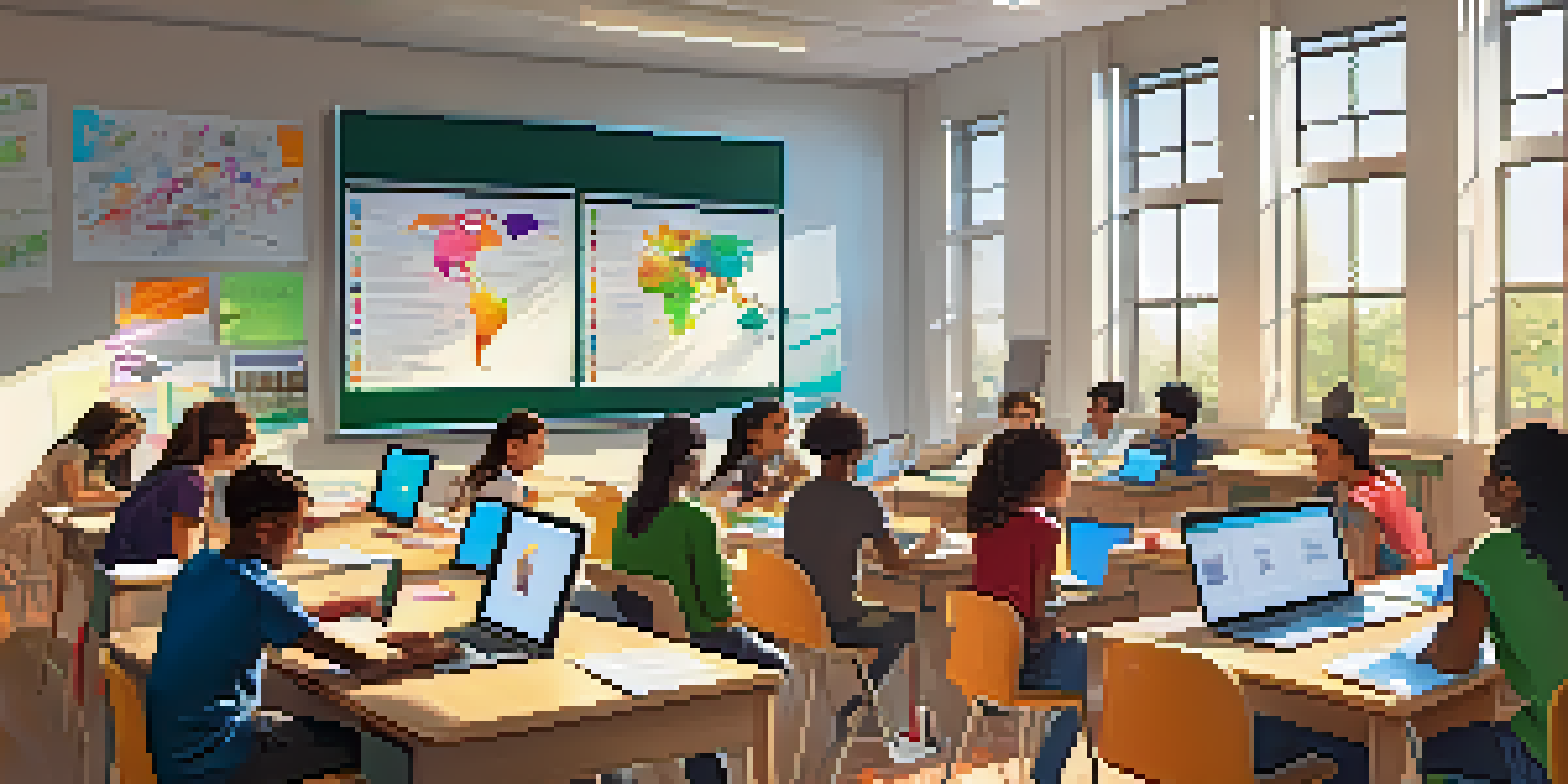The Role of Social Media in Educational Digital Access

Understanding Educational Digital Access Through Social Media
Digital access in education refers to the ability to obtain and use digital resources for learning. Social media platforms have become essential tools in bridging the gap between students and educational materials. They create pathways for communication and resource sharing that were once limited to traditional classroom settings.
The great thing about social media is that it gives everyone a voice and a platform to share their ideas.
Platforms like Facebook, Twitter, and Instagram are not just for socializing; they're increasingly being used to disseminate educational content. From study groups to online lectures, social media enables a collaborative learning environment where knowledge can be shared freely. This democratization of information is crucial for students in underserved communities.
Moreover, social media allows educators to reach a broader audience, fostering an inclusive learning environment. By sharing resources and information widely, they can engage students from diverse backgrounds, ensuring that everyone has a chance to succeed in their educational pursuits.
Increasing Collaboration Among Students and Teachers
Collaboration is key in modern education, and social media platforms facilitate this in remarkable ways. Students can connect with their peers for group projects or discussions, regardless of geographical barriers. This ability to collaborate online not only enhances learning but also builds essential communication skills.

Teachers, too, benefit from these platforms, as they can share best practices and resources with one another. Educators can join groups or forums specifically designed for their subject areas, exchanging ideas that can improve their teaching methods. This community-building aspect of social media enriches the overall educational experience.
Social Media Enhances Learning Access
Platforms like Facebook and Twitter facilitate access to educational resources and foster communication among students and educators.
Additionally, platforms like LinkedIn offer networking opportunities for both students and educators. By connecting with professionals in their fields, students can gain insights into real-world applications of their studies, making their education more relevant and engaging.
Access to Diverse Educational Resources and Content
One of the greatest advantages of social media in education is the access it provides to a wealth of resources. From educational videos on YouTube to articles shared on Twitter, students have a plethora of information at their fingertips. This easy access encourages self-directed learning and exploration beyond the classroom.
Education is the most powerful weapon which you can use to change the world.
Social media also fosters a culture of sharing among educators. Teachers can curate and share resources with one another, creating a rich repository of materials for various subjects. This collaborative sharing not only enhances the quality of education but also saves time and effort in resource gathering.
Moreover, platforms like Pinterest allow educators to find creative teaching ideas and lesson plans. By tapping into this collective intelligence, both students and teachers can benefit from innovative approaches to learning that they might not have encountered otherwise.
Enhancing Engagement Through Interactive Learning
Engagement is crucial for effective learning, and social media brings a unique interactive element to education. Features like polls, quizzes, and live discussions keep learners actively involved, making the educational experience more enjoyable and less monotonous. This interactivity can be particularly beneficial for younger audiences, who may thrive in a dynamic learning environment.
Furthermore, educators can use social media to create gamified learning experiences. By incorporating elements of competition and reward, they can motivate students to engage with the material more deeply. This approach not only enhances retention but also makes learning fun.
Collaboration Boosts Educational Engagement
Social media encourages collaboration between students and teachers, enriching the learning experience through shared ideas and resources.
Additionally, real-time feedback is another advantage of using social media in education. Students can ask questions and receive answers instantly, allowing them to clarify doubts and deepen their understanding without delay. This immediacy fosters a more responsive learning atmosphere.
Social Media's Role in Lifelong Learning Opportunities
Social media is not just for students; it plays a vital role in lifelong learning for individuals of all ages. Platforms like LinkedIn Learning and Facebook groups dedicated to professional development offer courses and resources for continuous skill-building. This makes it easier for anyone to pursue education at their own pace and convenience.
Moreover, the informal nature of social media encourages people to learn in a more relaxed setting. They can join discussions, share their experiences, and learn from others in a way that feels accessible and engaging. This approach can be particularly appealing for adults who may find traditional learning environments intimidating.
Additionally, social media allows professionals to stay updated with industry trends and advancements. By following thought leaders and educational organizations, individuals can gain insights that keep their skills relevant in an ever-evolving job market.
Bridging the Digital Divide with Social Media Initiatives
While social media has the potential to enhance educational access, there's still a significant digital divide that needs addressing. Many students lack reliable internet access or digital devices, which limits their ability to benefit from these online resources. However, various initiatives are emerging to bridge this gap.
For instance, organizations are leveraging social media to raise awareness about digital inequities and mobilize resources. Campaigns aimed at providing devices or internet access to underserved communities can help level the playing field, ensuring that all students can participate in digital learning.
Addressing the Digital Divide
Initiatives are emerging to tackle the digital divide, ensuring equitable access to educational opportunities through social media.
Moreover, educational institutions are increasingly recognizing the importance of inclusive practices. By incorporating social media into their outreach efforts, they can engage with students who might otherwise feel disconnected. This proactive approach can foster a more equitable educational landscape.
Challenges and Considerations in Using Social Media for Education
Despite its many benefits, using social media for educational purposes does come with challenges. Issues like misinformation, cyberbullying, and privacy concerns can create a minefield for both students and educators. Addressing these challenges requires thoughtful strategies and clear guidelines to ensure a safe learning environment.
Another consideration is the potential for distraction. With endless content available, students may find it hard to stay focused on educational materials. Educators must find ways to guide students in using social media effectively, emphasizing the importance of balance and self-discipline.

Finally, educators must be aware of their own digital footprints. They should model appropriate online behavior and teach students about digital citizenship—an essential skill in today's interconnected world. By promoting responsible use of social media, educators can help students navigate these platforms positively.
The Future of Social Media in Educational Digital Access
Looking ahead, the role of social media in education is likely to expand even further. As technology evolves, we can expect to see innovative features that enhance interactivity and engagement in learning. Virtual reality classrooms and augmented reality tools may soon be integrated into social media platforms, offering immersive learning experiences.
Moreover, the increasing focus on personalized learning will likely influence how social media is used in education. Tailored content that meets individual student needs will create more effective learning paths, making education more relevant and engaging.
Ultimately, the future of social media in education hinges on collaboration between educators, students, and tech developers. By working together, they can create a more inclusive and effective educational landscape that harnesses the power of social media to enhance learning for all.